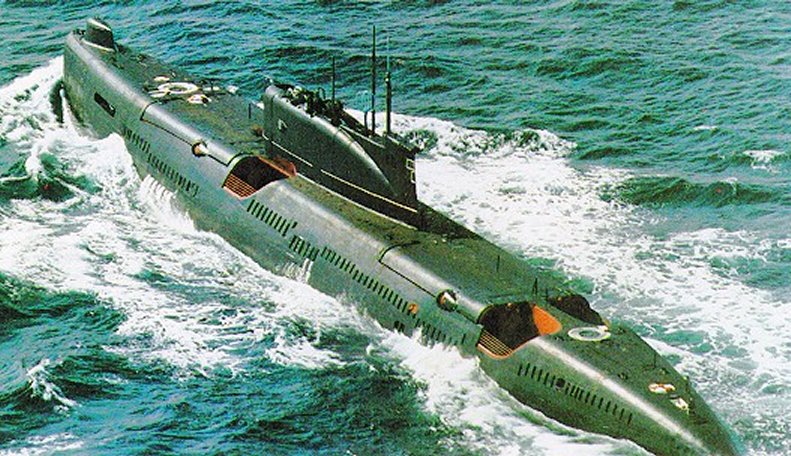红色鲨鱼-前苏联潜艇舰队全集-大吐大图[New]
来源:百度文库 编辑:超级军网 时间:2024/04/28 16:25:29
Project 949 Granit / Oscar I
Project 949A Antey / Oscar II
"奥斯卡"级巡航导弹核潜艇-航母克星水下版
"奥斯卡-I" 共建两艘,首舰82年服役.现已全部退役
"奥斯卡-II"共建10艘,8艘在役.首舰86年入役.
"奥斯卡"级的特色就是艇两侧的24枚SS-N-19巡航导弹。
SS-N-19是一种远程,超音速,掠海飞行的多用途反舰导弹。79年庄北原苏联海军。最大速度2。5马赫,射程550公里。
"奥斯卡"级的任务是攻击航母编队,保护本国弹道导弹核潜艇,攻击商船等大型目标。
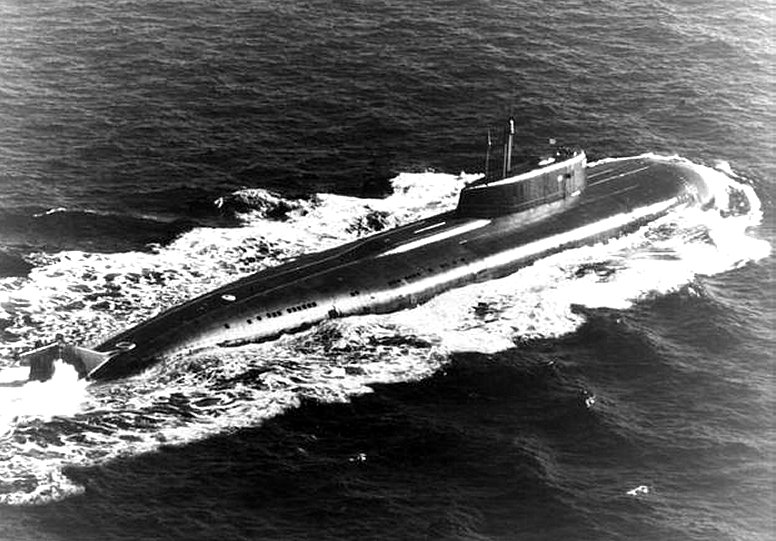
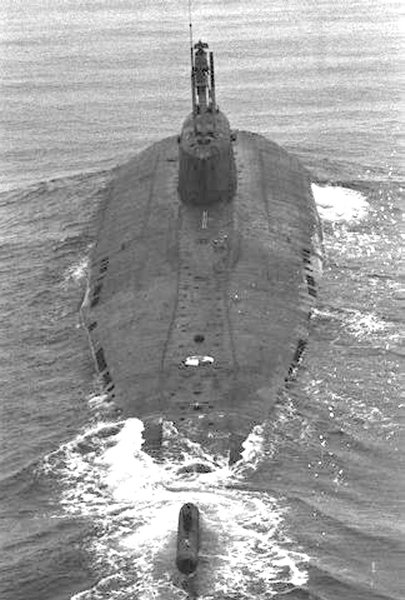
Project 949A Antey / Oscar II
"奥斯卡"级巡航导弹核潜艇-航母克星水下版
"奥斯卡-I" 共建两艘,首舰82年服役.现已全部退役
"奥斯卡-II"共建10艘,8艘在役.首舰86年入役.
"奥斯卡"级的特色就是艇两侧的24枚SS-N-19巡航导弹。
SS-N-19是一种远程,超音速,掠海飞行的多用途反舰导弹。79年庄北原苏联海军。最大速度2。5马赫,射程550公里。
"奥斯卡"级的任务是攻击航母编队,保护本国弹道导弹核潜艇,攻击商船等大型目标。


[此贴子已经被作者于2003-3-4 1:43:39编辑过]
Project 949A Antey / Oscar II
"奥斯卡"级巡航导弹核潜艇-航母克星水下版
"奥斯卡-I" 共建两艘,首舰82年服役.现已全部退役
"奥斯卡-II"共建10艘,8艘在役.首舰86年入役.
"奥斯卡"级的特色就是艇两侧的24枚SS-N-19巡航导弹。
SS-N-19是一种远程,超音速,掠海飞行的多用途反舰导弹。79年庄北原苏联海军。最大速度2。5马赫,射程550公里。
"奥斯卡"级的任务是攻击航母编队,保护本国弹道导弹核潜艇,攻击商船等大型目标。


[此贴子已经被作者于2003-3-4 1:43:39编辑过]
Project 949 Granit / Oscar I Project 949A Antey / Oscar II
"奥斯卡"级巡航导弹核潜艇-航母克星水下版
"奥斯卡-I" 共建两艘,首舰82年服役.现已全部退役
"奥斯卡-II"共建10艘,8艘在役.首舰86年入役.
"奥斯卡"级的特色就是艇两侧的24枚SS-N-19巡航导弹。
SS-N-19是一种远程,超音速,掠海飞行的多用途反舰导弹。79年庄北原苏联海军。最大速度2。5马赫,射程550公里。
"奥斯卡"级的任务是攻击航母编队,保护本国弹道导弹核潜艇,攻击商船等大型目标。


[此贴子已经被作者于2003-3-4 1:43:39编辑过]
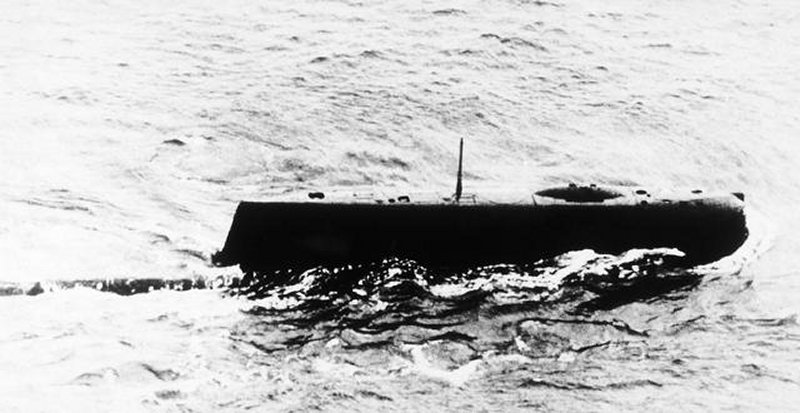

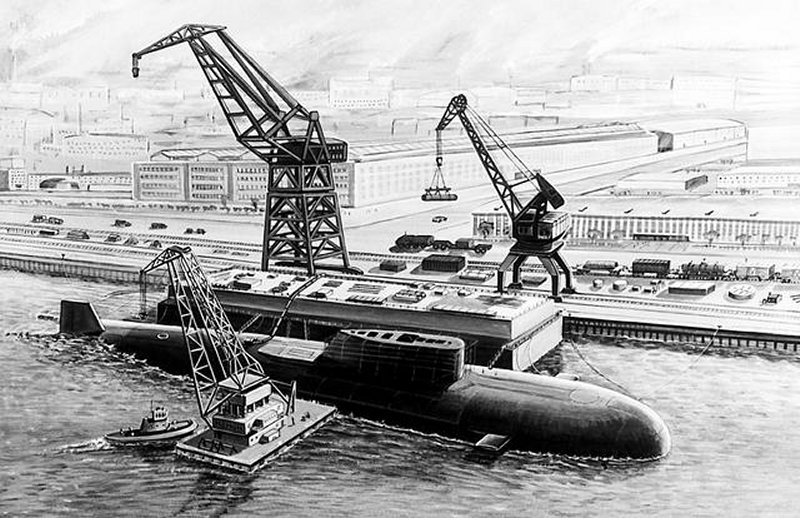
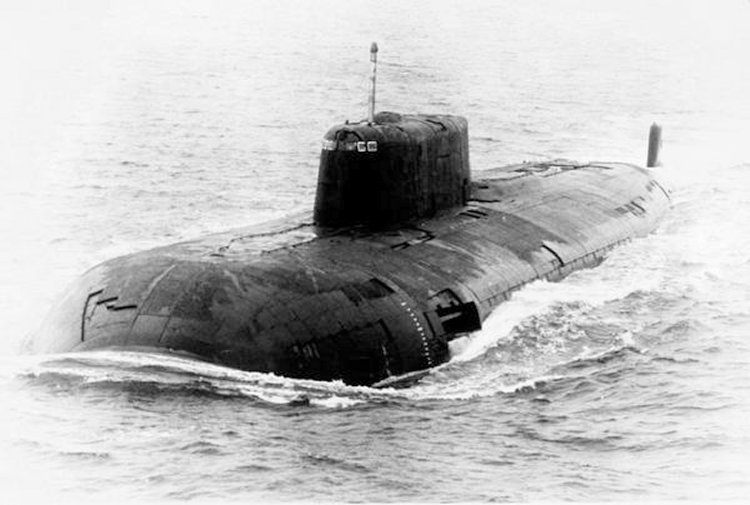
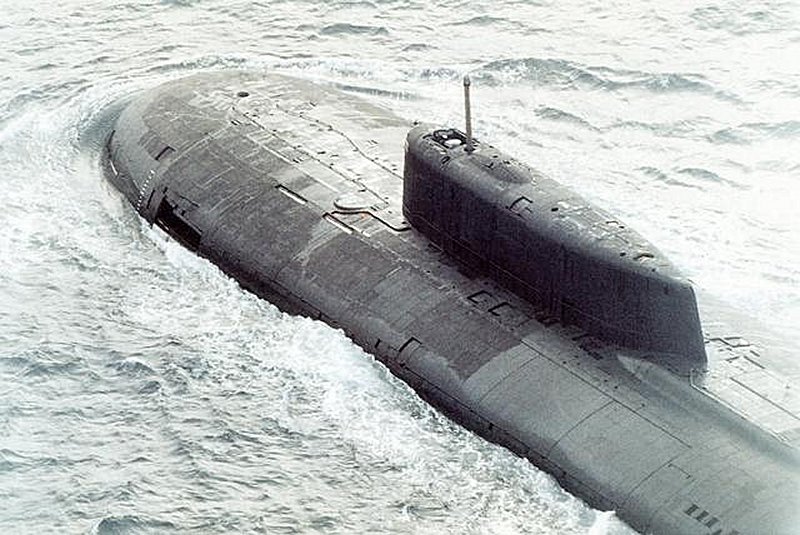
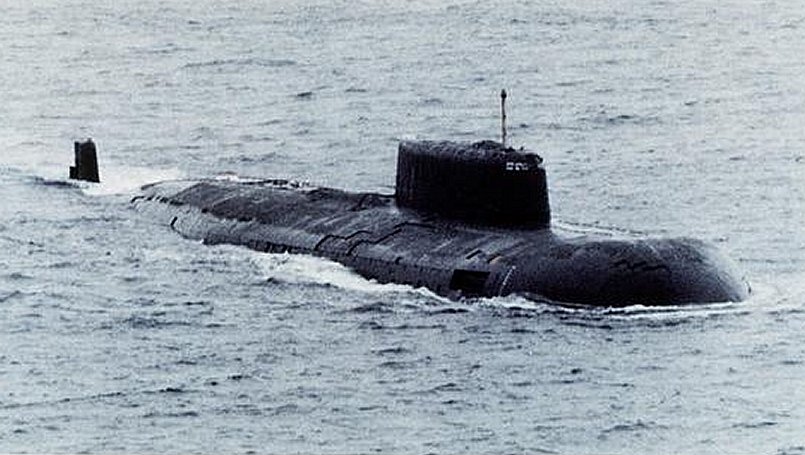
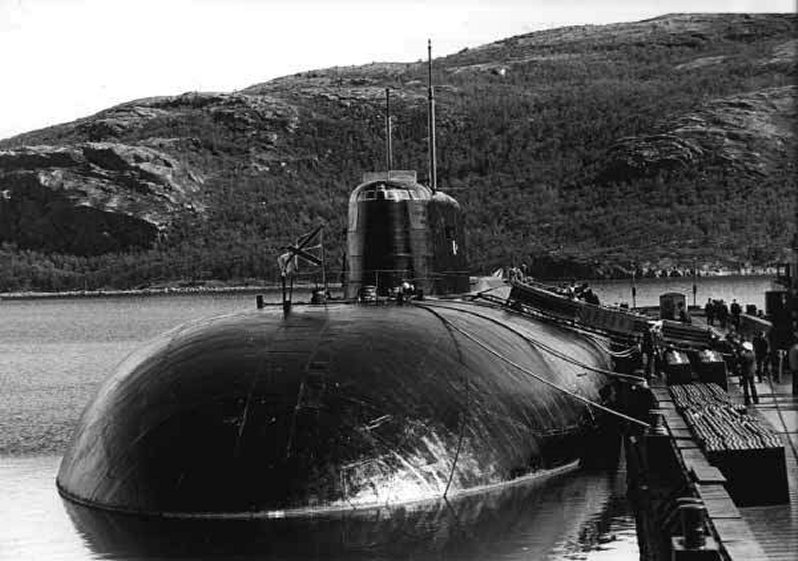
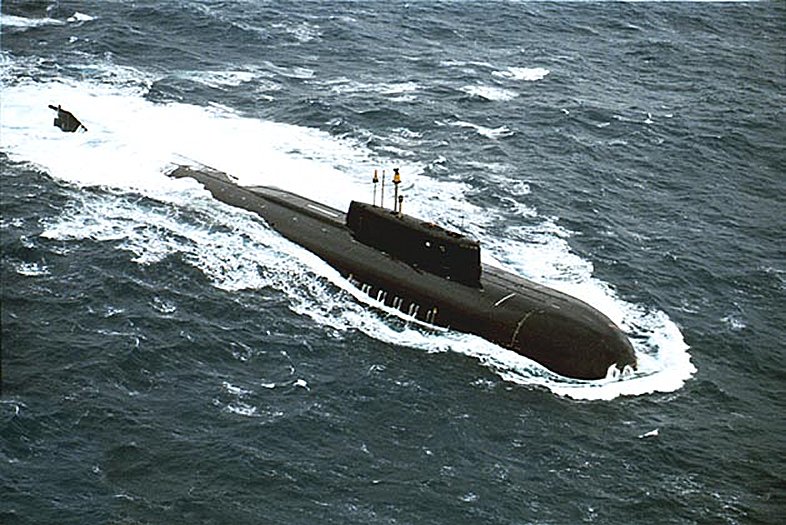
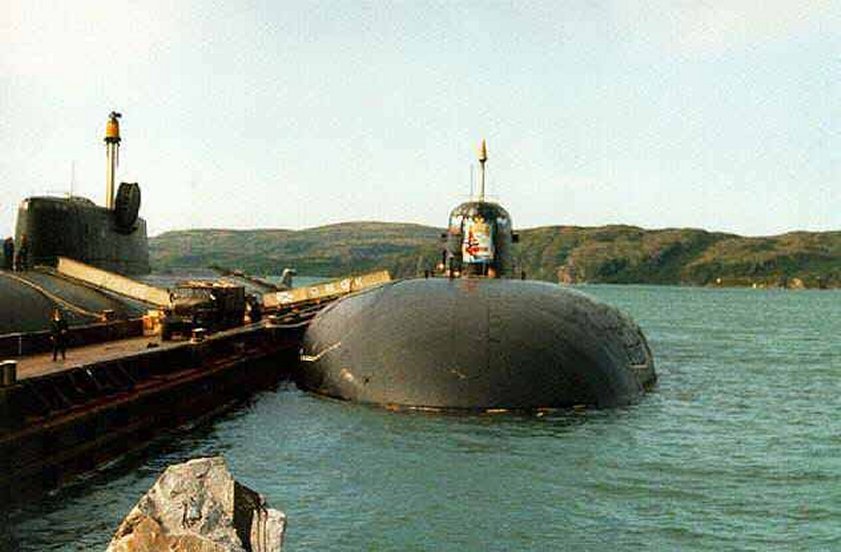
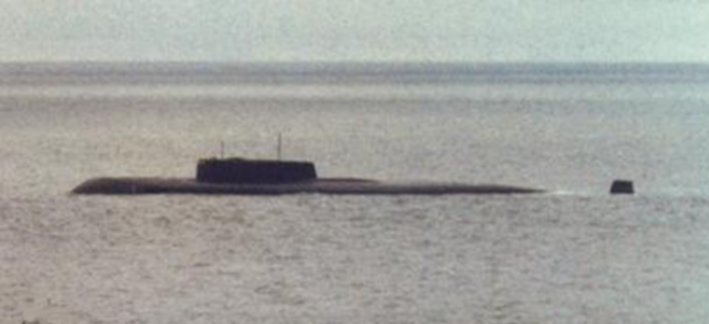
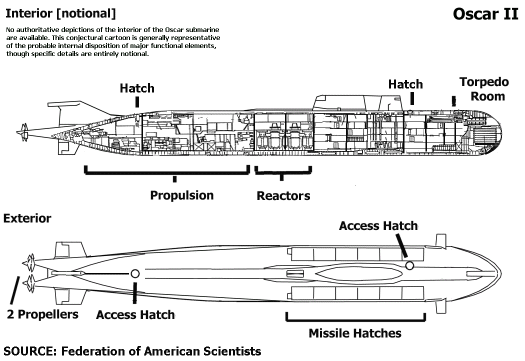
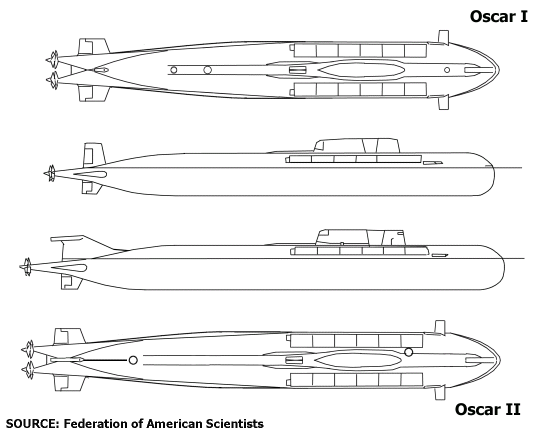
Specifications
949 (Oscar-I) 949A (Oscar-II)
Displacement (tons): 12,500 surfaced
15,500 - 22,500 submerged 13,400 - 14,700 surfaced
16,400 - 24,000 submerged
Speed (kts): 32 knots dived
16 kts surfaced 32 knots dived
16 kts surfaced
Dimensions (m): 143.0 meters long
18.2 meters beam (20.1 with stabilizers)
9.0 meters draft 154.0 meters long
18.2 meters beam
9.0 meters draft
Propulsion 2 VM-5 190 MWt pressurized-water nuclear reactors (OK-650b)
2 steam turbines - 90,000 shp
Propulsion 2 4-bladed propellers 2 7-bladed propellers
Endurance: 50 days
Diving depth: 300-600 meters [by various estimates]
Crew : 94 total
Armament: 24 - SS-N-19 / P-700 Granit
24 - torpedoes/tube-launched weapons
4 - 533 mm tubes - SS-N-15 Starfish / 82-P missiles or torpedoes
4 - 650 mm tubes - SS-N-16 Stallion / 85-P missiles or torpedoes
Electronics Radar
Snoop Pair or Snoop Half Surface Search
Rim Hat intercept array
Sonar
Shark Gill (MGK-503) hull mounted
Shark Rib flank array
Mouse Roar MG-519 Hull mounted
Pelamida towed array
2 periscopes
Class Listing
Boat Shipyard Fleet Chronology Notes
NO. Name Laid Down Launched Comm. Stricken
Project 949 ("Granit" type), NATO code "Oscar I"
1 K-525 Arkhangelsk SY 402 NOR 1978 04/**/1980 1982 1996 12/30/80 named "Minsky Komsomolets"
1991 renamed
1996 deactivated
2000 to be dismantled at Sevmash
2 K-206 Murmansk SY 402 NOR 1980? 12/**/1982 1983 1996 1991 named
1996 deactivated
2000 to be dismantled at Sevmash
Project 949A ("Antey" type), NATO code "Oscar II"
1 K-148 Orenburg SY 402 NOR ---------- 08/**/1985 07/**/1986
12/**/1986 ?? 1998 ex-Krasnodar [name as of 1995]
ex-Vologda
2000 probably active
2000 laid up awaiting disposal ??
2 K-132 Irkutsk SY 402 PAC ---------- **/**/1986
03/**/1986 **/**/1987
01/**/1987 ? 1998 (name also reported as "Belgorod")
2000 in reserve
2000 laid up awaiting disposal ?
3 K-119 Voronezh SY 402 NOR
PAC ? ---------- **/**/1986
12/**/1987 **/**/1988
12/**/1988 (name also reported as "Krasnoyarsk"
"Tambov" or "Chel'yabinsk")
2000 active
4 K-173 Krasnoyarsk SY 402 NOR ---------- **/**/1987
01/**/1989 **/**/1988
12/**/1989 ? 1997-8 (name also reported as "Veronesh")
(name mis-reported as "Chelyabinsk")
1997-8 deactivated
2000 laid up awaiting disposal ?
5 K-410 Smolensk SY 402 NOR ---------- **/**/1988
12/**/1989 **/**/1990
12/**/1990 2000 active
6 K-442 Chelyabinsk SY 402 PAC ---------- **/**/1989
01/**/1990 12/29/1990
01/**/1991 (name also reported as "Pskov")
(name mis-reported as "Tomsk")
2000 active
7 K-456 Viliuczinsk SY 402 PAC ---------- **/**/1990
12/**/1991 **/**/1991
11/**/1992 (ex-"Kasatka", possibly "Tambov")
09/**/1993 to Pacific Fleet
2000 active
8 K-266 Orel SY 402 NOR ---------- 01/**/1992
05/22/1992 12/**/1992
01/**/1993 (ex-"Severodvinsk")
2000 active
9 K-186 Omsk SY 402 NOR ---------- 05/08/1993 10/27/1993
12/15/1993 (possibly renamed
"Petropavlosk Kamchatsky")
2000 active
10 K-141 Kursk SY 402 NOR 1992 05/**/1994 10/**/1994
12/30/1994
01/20/1995 8/12/2000
11 K-512 St.Georgy Pobeditel SY 402 PAC ---------- 07/18/1995
07/18/1996 02/28/1997
12/31/1997 (ex-"Tomsk")
08/1997 operational
01/26/1998 cooling system accident
2000 active
12 K-530 Belgorod SY 402 ---------- 05/**/1998
08/**/1999 ???? (name also reported as "Pskov")
2000 construction suspended??
13 K-139 Pskov? SY 402 ???? ???? ---------- [?? construction suspended ??]
14 K-___ SY 402 ???? ---------- ---------- [?? cancelled ??]
15 K-___ SY 402 ???? ---------- ---------- [?? cancelled ??]
949 (Oscar-I) 949A (Oscar-II)
Displacement (tons): 12,500 surfaced
15,500 - 22,500 submerged 13,400 - 14,700 surfaced
16,400 - 24,000 submerged
Speed (kts): 32 knots dived
16 kts surfaced 32 knots dived
16 kts surfaced
Dimensions (m): 143.0 meters long
18.2 meters beam (20.1 with stabilizers)
9.0 meters draft 154.0 meters long
18.2 meters beam
9.0 meters draft
Propulsion 2 VM-5 190 MWt pressurized-water nuclear reactors (OK-650b)
2 steam turbines - 90,000 shp
Propulsion 2 4-bladed propellers 2 7-bladed propellers
Endurance: 50 days
Diving depth: 300-600 meters [by various estimates]
Crew : 94 total
Armament: 24 - SS-N-19 / P-700 Granit
24 - torpedoes/tube-launched weapons
4 - 533 mm tubes - SS-N-15 Starfish / 82-P missiles or torpedoes
4 - 650 mm tubes - SS-N-16 Stallion / 85-P missiles or torpedoes
Electronics Radar
Snoop Pair or Snoop Half Surface Search
Rim Hat intercept array
Sonar
Shark Gill (MGK-503) hull mounted
Shark Rib flank array
Mouse Roar MG-519 Hull mounted
Pelamida towed array
2 periscopes
Class Listing
Boat Shipyard Fleet Chronology Notes
NO. Name Laid Down Launched Comm. Stricken
Project 949 ("Granit" type), NATO code "Oscar I"
1 K-525 Arkhangelsk SY 402 NOR 1978 04/**/1980 1982 1996 12/30/80 named "Minsky Komsomolets"
1991 renamed
1996 deactivated
2000 to be dismantled at Sevmash
2 K-206 Murmansk SY 402 NOR 1980? 12/**/1982 1983 1996 1991 named
1996 deactivated
2000 to be dismantled at Sevmash
Project 949A ("Antey" type), NATO code "Oscar II"
1 K-148 Orenburg SY 402 NOR ---------- 08/**/1985 07/**/1986
12/**/1986 ?? 1998 ex-Krasnodar [name as of 1995]
ex-Vologda
2000 probably active
2000 laid up awaiting disposal ??
2 K-132 Irkutsk SY 402 PAC ---------- **/**/1986
03/**/1986 **/**/1987
01/**/1987 ? 1998 (name also reported as "Belgorod")
2000 in reserve
2000 laid up awaiting disposal ?
3 K-119 Voronezh SY 402 NOR
PAC ? ---------- **/**/1986
12/**/1987 **/**/1988
12/**/1988 (name also reported as "Krasnoyarsk"
"Tambov" or "Chel'yabinsk")
2000 active
4 K-173 Krasnoyarsk SY 402 NOR ---------- **/**/1987
01/**/1989 **/**/1988
12/**/1989 ? 1997-8 (name also reported as "Veronesh")
(name mis-reported as "Chelyabinsk")
1997-8 deactivated
2000 laid up awaiting disposal ?
5 K-410 Smolensk SY 402 NOR ---------- **/**/1988
12/**/1989 **/**/1990
12/**/1990 2000 active
6 K-442 Chelyabinsk SY 402 PAC ---------- **/**/1989
01/**/1990 12/29/1990
01/**/1991 (name also reported as "Pskov")
(name mis-reported as "Tomsk")
2000 active
7 K-456 Viliuczinsk SY 402 PAC ---------- **/**/1990
12/**/1991 **/**/1991
11/**/1992 (ex-"Kasatka", possibly "Tambov")
09/**/1993 to Pacific Fleet
2000 active
8 K-266 Orel SY 402 NOR ---------- 01/**/1992
05/22/1992 12/**/1992
01/**/1993 (ex-"Severodvinsk")
2000 active
9 K-186 Omsk SY 402 NOR ---------- 05/08/1993 10/27/1993
12/15/1993 (possibly renamed
"Petropavlosk Kamchatsky")
2000 active
10 K-141 Kursk SY 402 NOR 1992 05/**/1994 10/**/1994
12/30/1994
01/20/1995 8/12/2000
11 K-512 St.Georgy Pobeditel SY 402 PAC ---------- 07/18/1995
07/18/1996 02/28/1997
12/31/1997 (ex-"Tomsk")
08/1997 operational
01/26/1998 cooling system accident
2000 active
12 K-530 Belgorod SY 402 ---------- 05/**/1998
08/**/1999 ???? (name also reported as "Pskov")
2000 construction suspended??
13 K-139 Pskov? SY 402 ???? ???? ---------- [?? construction suspended ??]
14 K-___ SY 402 ???? ---------- ---------- [?? cancelled ??]
15 K-___ SY 402 ???? ---------- ---------- [?? cancelled ??]
[此贴子已经被作者于2003-3-3 20:08:17编辑过]
[此贴子已经被作者于2003-3-3 22:02:47编辑过]
[此贴子已经被作者于2003-3-3 21:58:23编辑过]
[此贴子已经被作者于2003-3-3 21:58:53编辑过]
[此贴子已经被作者于2003-3-3 22:08:43编辑过]
[此贴子已经被作者于2003-3-4 0:22:25编辑过]
[此贴子已经被作者于2003-3-3 22:42:21编辑过]
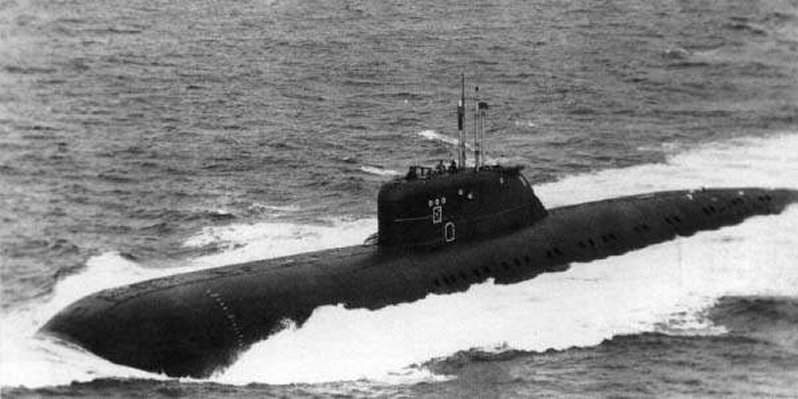
Project 670 Skat / Charlie I
Project 670M Skat-M / Charlie II
The CHARLIE was originally planned as a small, "mass-production" submarine that would be the lower-cost complement to the more expensive PAPA design, which clearly could not be built in sufficient numbers [in fact, only a single PAPA was built]. The Charlie SSGN was the first Soviet submarine to deploy submerged launch antiship missiles. In common with American submarines, and unique among Soviet combat nuclear submarines, the Charlie class had a single reactor and a single propeller shaft -- all other Soviet submarine classes feature two reactors and two propellers. With only a single reactor (VM-4 type water-cooled), the Charlie-class was limited to a top speed of 24 knots, which was insufficient to keep pace with a 30-knot carrier battle group.
The Charlie seemed to eliminate many of the problems inherent in the Echo design and concept of operations. It used targeting data from the first Soviet ocean surveillance satellites, which were intended to substitute for the vulnerable and range-limited maritime surveillance aircraft. In practice, the space-based ocean surveillance system did not live up to initial expectations, and the Charlie remained dependent on surveillance for target acquisition support. Although the shorter range of the SS-N-7 compared to the SS-N-3 required a closer approach to the target, it also reduced the flight time of the missile and eliminated the need for mid-course guidance. This eliminated the need for a guidance radar on the submarine, which allowed a fire and forget submerged launch.
The Charlie-I was originally designed to carry the SS-N-9 anti-shipping cruise missile, which had been planned for the PAPA class. When the SS-N-9 missile was not ready in time for the Charlie-I class, the SS-N-7 [a modified version of the SS-N-2 Styx], was substituted. A total of 11 or 12 Charlie I submarines, carrying 8 SS-N-7s of approximately 30 mile range, were built between 1967 and 1972 at a rate of about two a year. The Charlie II provided the SS-N-9 armament originally planned for the Charlie I class, along with an improved fire control system. Six Charlie II submarines, each with 8 SS-N-9s of 60 mile range, followed between 1972 and 1980. The slower construction rate of the Charlie II suggested that the design was deemed less than satisfactory. Indeed, the Charlie SSGNs were by far the smallest class of the second generation of Soviet nuclear submarines which, also included 49 Victor SSNs and 76 Yankee/Delta SSBNs. All submarines of both classes had been discarded by 1994. Contrary to some expectations, there was no Charlie III class.
K429 (a Charlie I class submarine) sank on 23 June 1983 in the Savannaya Bay in the Bering Sea. The boat was raised and returned to service. Unluckily, she sank again alongside the jetty on 13 September 1985. The incident led to the loss 16 lives and the imprisonment of the submarine commander. In January 1988 the Soviets leased a Charlie I to India, where she served until January 1991 as the Chakra. Some reports suggesting a that a second Charlie-class unit would be leased to India [possibly to be named the Chitra] were erroneous.
Specifications
Project 670 / Charlie I Project 670M / Charlie II
Displacement (tons): 4,000 surfaced
5,000 submerged 4,500 surfaced
5,400 submerged
Speed (kts): 23 knots dived
16 kts surfaced
Dimensions (m): 94.0 meters long
10.0 meters beam
8.0 meters draft 102.0 meters long
10.0 meters beam
8.0 meters draft
Propulsion 1 VM-5 pressurized-water nuclear reactor
1 steam turbine 20,000 shp
1 5-bladed propeller
Endurance:
Crew about 100
Armament: 8 SS-N-7 Starbright
6 21-in (533-mm) torpedo tubes (fwd)
12 torpedoes or
12 SS-N-15 Starfish
8 SS-N-9 Siren
6 21-in (533-mm) torpedo tubes (fwd)
12 torpedoes or
12 SS-N-15 Starfish
Electronics Radar
Snoop Tray Surface Search
Sonar
Shark Teeth bow-mounted
periscopes
Class Listing
Boat Shipyard Chronology Notes
NO. Name Laid Down Launched Comm. Stricken
Project 670A("Skat" type), NATO code "Charlie I"
K-43 KS ---------- ---------- 1968 ---------- 01/1988-01/1991 project 06709, to India (Chakra)
1991 in reserve
K-87 KS ---------- ---------- 1969 ---------- 1972 redesignated to K-212
1992 in reserve
K-25 KS ---------- ---------- 1969 ---------- 1993 in reserve
K-121 KS ---------- ---------- 1969 ---------- 1993 in reserve
K-313 KS ---------- ---------- 1970 ---------- 12/1985 primary coolant leak,
probably in reserve
K-308 KS ---------- ---------- 09/20/1970 ---------- 1993 in reserve
K-320 KS ---------- ---------- 09/15/1971 ---------- 01/18/1970 reactor accident under construction
1994 in reserve
K-303 KS ---------- ---------- 1971 ---------- 1995 in reserve
K-325 KS ---------- ---------- 1971 ---------- 1995 in reserve
K-429 KS ---------- ---------- 1972 1987 06/24/1983 sunk (later recovered)
09/13/1985 sunk again
K-201 KS ---------- ---------- 12/26/1972 ---------- 1994 in reserve
Project 670M("Skat-M" type), NATO code "Charlie II"
K-452 Berkut KS ---------- 1973 1974 ---------- 1989 named
project P-670 converted
1994 in reserve
K-458 KS ---------- 1975 1976 ---------- 1992 in reserve
K-479 KS ---------- 1977 1978 ---------- 1993 in reserve
in storage in Nerpa naval shipyard
K-503 KS ---------- 1978 1979 ---------- 1994 in reserve
K-508 KS ---------- 1979 1980 ---------- 1994 in reserve
K-209 KS ---------- 1980 1982 ---------- 1994 in reserve
Project 670M Skat-M / Charlie II
The CHARLIE was originally planned as a small, "mass-production" submarine that would be the lower-cost complement to the more expensive PAPA design, which clearly could not be built in sufficient numbers [in fact, only a single PAPA was built]. The Charlie SSGN was the first Soviet submarine to deploy submerged launch antiship missiles. In common with American submarines, and unique among Soviet combat nuclear submarines, the Charlie class had a single reactor and a single propeller shaft -- all other Soviet submarine classes feature two reactors and two propellers. With only a single reactor (VM-4 type water-cooled), the Charlie-class was limited to a top speed of 24 knots, which was insufficient to keep pace with a 30-knot carrier battle group.
The Charlie seemed to eliminate many of the problems inherent in the Echo design and concept of operations. It used targeting data from the first Soviet ocean surveillance satellites, which were intended to substitute for the vulnerable and range-limited maritime surveillance aircraft. In practice, the space-based ocean surveillance system did not live up to initial expectations, and the Charlie remained dependent on surveillance for target acquisition support. Although the shorter range of the SS-N-7 compared to the SS-N-3 required a closer approach to the target, it also reduced the flight time of the missile and eliminated the need for mid-course guidance. This eliminated the need for a guidance radar on the submarine, which allowed a fire and forget submerged launch.
The Charlie-I was originally designed to carry the SS-N-9 anti-shipping cruise missile, which had been planned for the PAPA class. When the SS-N-9 missile was not ready in time for the Charlie-I class, the SS-N-7 [a modified version of the SS-N-2 Styx], was substituted. A total of 11 or 12 Charlie I submarines, carrying 8 SS-N-7s of approximately 30 mile range, were built between 1967 and 1972 at a rate of about two a year. The Charlie II provided the SS-N-9 armament originally planned for the Charlie I class, along with an improved fire control system. Six Charlie II submarines, each with 8 SS-N-9s of 60 mile range, followed between 1972 and 1980. The slower construction rate of the Charlie II suggested that the design was deemed less than satisfactory. Indeed, the Charlie SSGNs were by far the smallest class of the second generation of Soviet nuclear submarines which, also included 49 Victor SSNs and 76 Yankee/Delta SSBNs. All submarines of both classes had been discarded by 1994. Contrary to some expectations, there was no Charlie III class.
K429 (a Charlie I class submarine) sank on 23 June 1983 in the Savannaya Bay in the Bering Sea. The boat was raised and returned to service. Unluckily, she sank again alongside the jetty on 13 September 1985. The incident led to the loss 16 lives and the imprisonment of the submarine commander. In January 1988 the Soviets leased a Charlie I to India, where she served until January 1991 as the Chakra. Some reports suggesting a that a second Charlie-class unit would be leased to India [possibly to be named the Chitra] were erroneous.
Specifications
Project 670 / Charlie I Project 670M / Charlie II
Displacement (tons): 4,000 surfaced
5,000 submerged 4,500 surfaced
5,400 submerged
Speed (kts): 23 knots dived
16 kts surfaced
Dimensions (m): 94.0 meters long
10.0 meters beam
8.0 meters draft 102.0 meters long
10.0 meters beam
8.0 meters draft
Propulsion 1 VM-5 pressurized-water nuclear reactor
1 steam turbine 20,000 shp
1 5-bladed propeller
Endurance:
Crew about 100
Armament: 8 SS-N-7 Starbright
6 21-in (533-mm) torpedo tubes (fwd)
12 torpedoes or
12 SS-N-15 Starfish
8 SS-N-9 Siren
6 21-in (533-mm) torpedo tubes (fwd)
12 torpedoes or
12 SS-N-15 Starfish
Electronics Radar
Snoop Tray Surface Search
Sonar
Shark Teeth bow-mounted
periscopes
Class Listing
Boat Shipyard Chronology Notes
NO. Name Laid Down Launched Comm. Stricken
Project 670A("Skat" type), NATO code "Charlie I"
K-43 KS ---------- ---------- 1968 ---------- 01/1988-01/1991 project 06709, to India (Chakra)
1991 in reserve
K-87 KS ---------- ---------- 1969 ---------- 1972 redesignated to K-212
1992 in reserve
K-25 KS ---------- ---------- 1969 ---------- 1993 in reserve
K-121 KS ---------- ---------- 1969 ---------- 1993 in reserve
K-313 KS ---------- ---------- 1970 ---------- 12/1985 primary coolant leak,
probably in reserve
K-308 KS ---------- ---------- 09/20/1970 ---------- 1993 in reserve
K-320 KS ---------- ---------- 09/15/1971 ---------- 01/18/1970 reactor accident under construction
1994 in reserve
K-303 KS ---------- ---------- 1971 ---------- 1995 in reserve
K-325 KS ---------- ---------- 1971 ---------- 1995 in reserve
K-429 KS ---------- ---------- 1972 1987 06/24/1983 sunk (later recovered)
09/13/1985 sunk again
K-201 KS ---------- ---------- 12/26/1972 ---------- 1994 in reserve
Project 670M("Skat-M" type), NATO code "Charlie II"
K-452 Berkut KS ---------- 1973 1974 ---------- 1989 named
project P-670 converted
1994 in reserve
K-458 KS ---------- 1975 1976 ---------- 1992 in reserve
K-479 KS ---------- 1977 1978 ---------- 1993 in reserve
in storage in Nerpa naval shipyard
K-503 KS ---------- 1978 1979 ---------- 1994 in reserve
K-508 KS ---------- 1979 1980 ---------- 1994 in reserve
K-209 KS ---------- 1980 1982 ---------- 1994 in reserve
[此贴子已经被作者于2003-3-3 22:45:00编辑过]
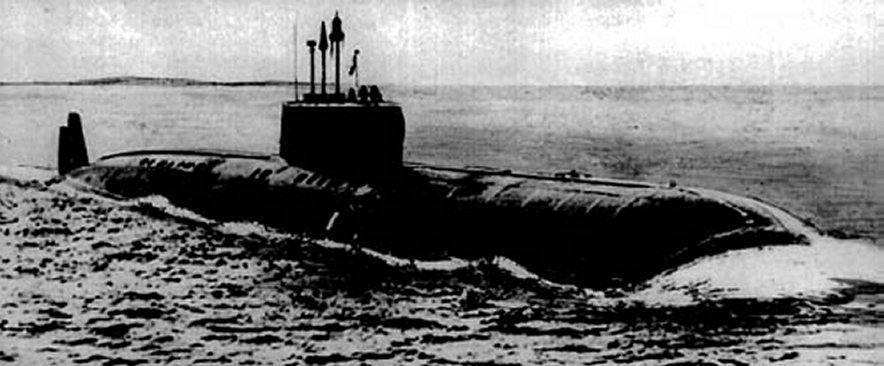
Project 661 Anchar / Papa
A predecessor to the famous ALFA-class attack submarine, the Project 661 Anchar [Papa] was designed as an extremely fast anti-shipping cruise missile submarine. The Papa design included 10 SS-N-9 missiles in individual tubes forward of the sail, between the inner (pressure) hull and the outer hull. The US Navy was surprised in 1970 by the deployment of the Alfa-class attack submarine, whose 45 knot speed and 2000-2500 foot operating depth greatly surpased previous Soviet or American submarines. The Alfa used a high power density, liquid metal reactor plant which greatly increased her power-to-weight and volume ratios. It also featured a titanium pressure hull which reduced the hull weight needed for extreme operating depths. The Papa SSGN appeared to incorporate similar design technologies for the antiship cruise missile mission. The K-162 was the world's fastest submarine, reportedly reaching a record speed of 44.7 knots on trials [causing signficant damage to topside equipment in the process]. The high speed of the design came at the price of excessive noisy and high construction costs. The Alfa did not enter production until the late 1970s, with only six units built, while only a single PAPA was ever deployed. Instead, the Soviets focused on building the more traditional submarines.
Specifications
Displacement (tons): 5,200 surfaced
7,000 submerged
Speed (kts): 44.7 knots dived
Operating Depth 400 meters
Dimensions (m): 106.7 meters long
11.6 meters beam
8.0 meters draft
Propulsion 2 VM-5m pressurized-water nuclear reactors, 177.4 MWt
2 steam turbines; ??,000 shp
2 ?-bladed propellers
Endurance:
Crew 82
Armament: 10 - SS-N-9
torpedo tubes
Electronics Radar
Sonar
2 periscopes
Class Listing
Boat Shipyard Chronology Notes
NO. Name Laid Down Launched Comm. Stricken
K-162 SV 12/28/1963 12/21/1968 12/31/1969 ---------- redesignated to K-222
09/30/1980 reactor accident
1988 in reserve
in storage in Severodvinsk
A predecessor to the famous ALFA-class attack submarine, the Project 661 Anchar [Papa] was designed as an extremely fast anti-shipping cruise missile submarine. The Papa design included 10 SS-N-9 missiles in individual tubes forward of the sail, between the inner (pressure) hull and the outer hull. The US Navy was surprised in 1970 by the deployment of the Alfa-class attack submarine, whose 45 knot speed and 2000-2500 foot operating depth greatly surpased previous Soviet or American submarines. The Alfa used a high power density, liquid metal reactor plant which greatly increased her power-to-weight and volume ratios. It also featured a titanium pressure hull which reduced the hull weight needed for extreme operating depths. The Papa SSGN appeared to incorporate similar design technologies for the antiship cruise missile mission. The K-162 was the world's fastest submarine, reportedly reaching a record speed of 44.7 knots on trials [causing signficant damage to topside equipment in the process]. The high speed of the design came at the price of excessive noisy and high construction costs. The Alfa did not enter production until the late 1970s, with only six units built, while only a single PAPA was ever deployed. Instead, the Soviets focused on building the more traditional submarines.
Specifications
Displacement (tons): 5,200 surfaced
7,000 submerged
Speed (kts): 44.7 knots dived
Operating Depth 400 meters
Dimensions (m): 106.7 meters long
11.6 meters beam
8.0 meters draft
Propulsion 2 VM-5m pressurized-water nuclear reactors, 177.4 MWt
2 steam turbines; ??,000 shp
2 ?-bladed propellers
Endurance:
Crew 82
Armament: 10 - SS-N-9
torpedo tubes
Electronics Radar
Sonar
2 periscopes
Class Listing
Boat Shipyard Chronology Notes
NO. Name Laid Down Launched Comm. Stricken
K-162 SV 12/28/1963 12/21/1968 12/31/1969 ---------- redesignated to K-222
09/30/1980 reactor accident
1988 in reserve
in storage in Severodvinsk
[此贴子已经被作者于2003-3-3 22:24:57编辑过]
[此贴子已经被作者于2003-3-2 18:38:03编辑过]
Project 675 / Echo II
The Project 659 [Echo I] nuclear-powered cruise-missile submarines were designed to launch the land-attack version SS-N-3c Shaddock. They carried 6 Shaddock missiles in erectable launch tubes mounted in pairs above the pressure hull on both sides of the sail. The Echo I boats, which used a reactor and propulsion system similar to the Hotel SSBN and November SSN classes, were converted to attack submarines in the early 1970s. At least one and possibly two were decommissioned in the mid-1980s, while the remaining three or four units were decommissioned in 1990.
The Project 675 [Echo II] nuclear-powered cruise-missile submarines were modified to carry the Front series of radars [also featured on the Juliet-class SSG] that enabled them to launch the anti-shipping version of the Shaddock. These were primarily anti-carrier weapons, intended originally as a response to nuclear strikes against the Soviet Union by carrier-based aircraft like the A-3 Skywarrior. As such, their SS-N-3s came in both nuclear and conventional versions. A total of eight missiles were carried, two more than on the Echo-I, and the hull was lengthed five meters to accomodate the extra pair of launchers. According to Western estimates about 20 minutes was required to launch all eight missiles. To fire its missiles the submarine surfaced, deployed and activated a tracking radar, and remained on the surface linked to the high altitude cruise missile in flight via datalink, providing guidance commands based on the submarine radar's tracking data. The submarine itself was highly vulnerable to attack while on the surface operating its radar. A total of 29 Echo IIs were constructed between 1962 and 1968, of which perhaps 10 were converted to carry the improved SS-N-12 by the mid-1980s. All had been de-commissioned by the mid-1990s.
At least four Echo submarines have suffered serious accidents. In August 1980 a fire in an Echo II off Japan killed at least nine crewmembers. On 26 June 1989 a fire erupted in of the the two reactor compartments on an Echo II submarine of the Northern Fleet. The reactor had to be shut down, and the submarine surfaced to return to Murmansk under auxiliary diesel power. Several crew members were injured, but none were killed in the incident. There is some confusion over the numbering of the damaged submarines. According to one reasobably authoritative account, the Navy has four damaged submarines, of which three are in the Far East, in the Pavlovski Bay (project 675, serial No. 175 and 541 and project 671, serial No. 610) and one - in the North (project 675, serial No. 533). The cores of submarines No. 541 and 533 are planned to be discharged. These numbers are at variance with those reported by other sources, and certainly reflect at least in part the annoying Russian habit of re-designating their ships.
Specifications
Project 659 / Echo I Project 675 / Echo II
Displacement (tons): 4,500 tons surfaced
5,500 tons submerged 5,000 tons surfaced
6,000 tons submerged
Speed (kts): 20 kts surfaced
25 kts submerged 20 kts surfaced
23 kts submerged
Dimensions (m): 110.0 meters long
9.0 meters beam
7.5 meters draft 115.0 meters long
9.0 meters beam
7.5 meters draft
Propulsion 2 pressurized-water nuclear reactors
steam turbines; 25,000 shp
2 shafts 5-bladed propellers 2 pressurized-water nuclear reactors
steam turbines; 30,000 shp
2 shafts 5-bladed propellers
Endurance:
Crew about 75 about 90
Armament: 6 - SS-N-3
6 21-in (533-mm) torpedo tubes (fwd)
4 16-in (406-mm) torpedo tubes (aft)
8 - SS-N-3 or
8 - SS-N-12
6 21-in (533-mm) torpedo tubes (fwd)
4 16-in (406-mm) torpedo tubes (aft)
Electronics Radar
Front Door or Front Piece targeting
Snoop Tray Surface Search
Sonar
Herkules
Fez
Radar
Snoop Tray Surface Search
Sonar
Feniks
low-frequency
Class Listing
Boat Shipyard Chronology Notes
NO. Name Laid Down Launched Comm. Stricken
Project 659, NATO code "Echo I"
K-45 KM 12/28/1957 05/12/1959 09/18/1960 1990 06/1961 operational
1965-69 project 659T converted to SSN under SALT-1
K-59 KM ---------- ---------- 12/10/1961 1990 1965-69 project 659T converted to SSN under SALT-1
K-66 KM ---------- ---------- 12/10/1961 1990 1965-69 project 659T converted to SSN under SALT-1
'04/23/1980 fire (mutiny?)
in reserve
K-122 KM ---------- ---------- 04/13/1962 1981 1965-69 project 659T converted to SSN under SALT-1
'08/21/1981 reactor accident,stricken
K-259 KM ---------- ---------- 12/**/1962 1990 NO. possibly K-151
1965-69 project 659T converted to SSN under SALT-1
Project 675, NATO code "Echo II"
K-1 SV ---------- ---------- 1962-68 ---------- 1987 project 675MK converted (satellite targeting)
K-7 KM ---------- ---------- 1962-68 ---------- 1968 redesignated to K-127
K-10 KM ---------- ---------- 1962-68 1982 lead ship built at KM
1980 collided with Chinese submarine
K-22 Krasnovardeets SV ---------- ---------- 1962-68 ---------- 1993 project 675MK converted (satellite targeting)
K-23 KM ---------- ---------- 1962-68 ----------
K-28 SV ---------- ---------- 1962-68 ---------- redesignated to K-428
K-31 KM ---------- ---------- 1962-68 ---------- 04/29/1969 redesignated to K-431
01/13/1986 reactor accident,in reserve
K-34 Kefal KM ---------- ---------- 1962-68 ---------- redesignated to K-134
K-35 SV ---------- ---------- 1962-68 ---------- 1991 project 675MK converted (satellite targeting)
K-47 SV ---------- ---------- 1962-68 ---------- 09/26/1976 fire
K-48 KM ---------- ---------- 1962-68 ---------- project 675K converted (SLEP)
K-56 SV ---------- ---------- 1962-68 ---------- 06/13/1973 collided with research ship
K-57 KM ---------- ---------- 1962-68 ---------- redesignated to K-557
K-74 SV ---------- ---------- 1962-68 ----------
K-86 SV ---------- ---------- 1962-68 ---------- diver tranport converted
K-90 KM ---------- ---------- 1962-68 ----------
K-94 KM ---------- ---------- 1962-68 ----------
K-104 SV ---------- ---------- 1962-68 ---------- redesignated to K-144
K-108 KM ---------- ---------- 1962-68 ----------
K-116 KM ---------- ---------- 1962-68 ---------- 08/19/1978 reactor accident
K-125 SV ---------- ---------- 1962-68 ----------
K-128 KM ---------- ---------- 1962-68 ----------
K-135 KM ---------- ---------- 1962-68 ----------
K-166 SV ---------- ---------- 1962-68 ---------- lead ship built at SV
K-172 KM ---------- ---------- 1962-68 ----------
K-175 KM ---------- ---------- 1962-68 ----------
K-184 KM ---------- ---------- 1962-68 ----------
K-189 KM ---------- ---------- 1962-68 ---------- hull NO. possibly K-131
K-192 SV ---------- ---------- 1962-68 ---------- 06/25/1989 reactor accident,in reserve
in storage at Polyarny
The Project 659 [Echo I] nuclear-powered cruise-missile submarines were designed to launch the land-attack version SS-N-3c Shaddock. They carried 6 Shaddock missiles in erectable launch tubes mounted in pairs above the pressure hull on both sides of the sail. The Echo I boats, which used a reactor and propulsion system similar to the Hotel SSBN and November SSN classes, were converted to attack submarines in the early 1970s. At least one and possibly two were decommissioned in the mid-1980s, while the remaining three or four units were decommissioned in 1990.
The Project 675 [Echo II] nuclear-powered cruise-missile submarines were modified to carry the Front series of radars [also featured on the Juliet-class SSG] that enabled them to launch the anti-shipping version of the Shaddock. These were primarily anti-carrier weapons, intended originally as a response to nuclear strikes against the Soviet Union by carrier-based aircraft like the A-3 Skywarrior. As such, their SS-N-3s came in both nuclear and conventional versions. A total of eight missiles were carried, two more than on the Echo-I, and the hull was lengthed five meters to accomodate the extra pair of launchers. According to Western estimates about 20 minutes was required to launch all eight missiles. To fire its missiles the submarine surfaced, deployed and activated a tracking radar, and remained on the surface linked to the high altitude cruise missile in flight via datalink, providing guidance commands based on the submarine radar's tracking data. The submarine itself was highly vulnerable to attack while on the surface operating its radar. A total of 29 Echo IIs were constructed between 1962 and 1968, of which perhaps 10 were converted to carry the improved SS-N-12 by the mid-1980s. All had been de-commissioned by the mid-1990s.
At least four Echo submarines have suffered serious accidents. In August 1980 a fire in an Echo II off Japan killed at least nine crewmembers. On 26 June 1989 a fire erupted in of the the two reactor compartments on an Echo II submarine of the Northern Fleet. The reactor had to be shut down, and the submarine surfaced to return to Murmansk under auxiliary diesel power. Several crew members were injured, but none were killed in the incident. There is some confusion over the numbering of the damaged submarines. According to one reasobably authoritative account, the Navy has four damaged submarines, of which three are in the Far East, in the Pavlovski Bay (project 675, serial No. 175 and 541 and project 671, serial No. 610) and one - in the North (project 675, serial No. 533). The cores of submarines No. 541 and 533 are planned to be discharged. These numbers are at variance with those reported by other sources, and certainly reflect at least in part the annoying Russian habit of re-designating their ships.
Specifications
Project 659 / Echo I Project 675 / Echo II
Displacement (tons): 4,500 tons surfaced
5,500 tons submerged 5,000 tons surfaced
6,000 tons submerged
Speed (kts): 20 kts surfaced
25 kts submerged 20 kts surfaced
23 kts submerged
Dimensions (m): 110.0 meters long
9.0 meters beam
7.5 meters draft 115.0 meters long
9.0 meters beam
7.5 meters draft
Propulsion 2 pressurized-water nuclear reactors
steam turbines; 25,000 shp
2 shafts 5-bladed propellers 2 pressurized-water nuclear reactors
steam turbines; 30,000 shp
2 shafts 5-bladed propellers
Endurance:
Crew about 75 about 90
Armament: 6 - SS-N-3
6 21-in (533-mm) torpedo tubes (fwd)
4 16-in (406-mm) torpedo tubes (aft)
8 - SS-N-3 or
8 - SS-N-12
6 21-in (533-mm) torpedo tubes (fwd)
4 16-in (406-mm) torpedo tubes (aft)
Electronics Radar
Front Door or Front Piece targeting
Snoop Tray Surface Search
Sonar
Herkules
Fez
Radar
Snoop Tray Surface Search
Sonar
Feniks
low-frequency
Class Listing
Boat Shipyard Chronology Notes
NO. Name Laid Down Launched Comm. Stricken
Project 659, NATO code "Echo I"
K-45 KM 12/28/1957 05/12/1959 09/18/1960 1990 06/1961 operational
1965-69 project 659T converted to SSN under SALT-1
K-59 KM ---------- ---------- 12/10/1961 1990 1965-69 project 659T converted to SSN under SALT-1
K-66 KM ---------- ---------- 12/10/1961 1990 1965-69 project 659T converted to SSN under SALT-1
'04/23/1980 fire (mutiny?)
in reserve
K-122 KM ---------- ---------- 04/13/1962 1981 1965-69 project 659T converted to SSN under SALT-1
'08/21/1981 reactor accident,stricken
K-259 KM ---------- ---------- 12/**/1962 1990 NO. possibly K-151
1965-69 project 659T converted to SSN under SALT-1
Project 675, NATO code "Echo II"
K-1 SV ---------- ---------- 1962-68 ---------- 1987 project 675MK converted (satellite targeting)
K-7 KM ---------- ---------- 1962-68 ---------- 1968 redesignated to K-127
K-10 KM ---------- ---------- 1962-68 1982 lead ship built at KM
1980 collided with Chinese submarine
K-22 Krasnovardeets SV ---------- ---------- 1962-68 ---------- 1993 project 675MK converted (satellite targeting)
K-23 KM ---------- ---------- 1962-68 ----------
K-28 SV ---------- ---------- 1962-68 ---------- redesignated to K-428
K-31 KM ---------- ---------- 1962-68 ---------- 04/29/1969 redesignated to K-431
01/13/1986 reactor accident,in reserve
K-34 Kefal KM ---------- ---------- 1962-68 ---------- redesignated to K-134
K-35 SV ---------- ---------- 1962-68 ---------- 1991 project 675MK converted (satellite targeting)
K-47 SV ---------- ---------- 1962-68 ---------- 09/26/1976 fire
K-48 KM ---------- ---------- 1962-68 ---------- project 675K converted (SLEP)
K-56 SV ---------- ---------- 1962-68 ---------- 06/13/1973 collided with research ship
K-57 KM ---------- ---------- 1962-68 ---------- redesignated to K-557
K-74 SV ---------- ---------- 1962-68 ----------
K-86 SV ---------- ---------- 1962-68 ---------- diver tranport converted
K-90 KM ---------- ---------- 1962-68 ----------
K-94 KM ---------- ---------- 1962-68 ----------
K-104 SV ---------- ---------- 1962-68 ---------- redesignated to K-144
K-108 KM ---------- ---------- 1962-68 ----------
K-116 KM ---------- ---------- 1962-68 ---------- 08/19/1978 reactor accident
K-125 SV ---------- ---------- 1962-68 ----------
K-128 KM ---------- ---------- 1962-68 ----------
K-135 KM ---------- ---------- 1962-68 ----------
K-166 SV ---------- ---------- 1962-68 ---------- lead ship built at SV
K-172 KM ---------- ---------- 1962-68 ----------
K-175 KM ---------- ---------- 1962-68 ----------
K-184 KM ---------- ---------- 1962-68 ----------
K-189 KM ---------- ---------- 1962-68 ---------- hull NO. possibly K-131
K-192 SV ---------- ---------- 1962-68 ---------- 06/25/1989 reactor accident,in reserve
in storage at Polyarny
[此贴子已经被作者于2003-3-3 22:59:32编辑过]
